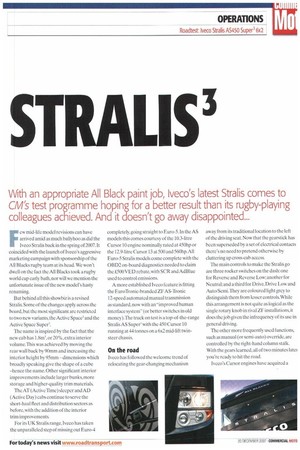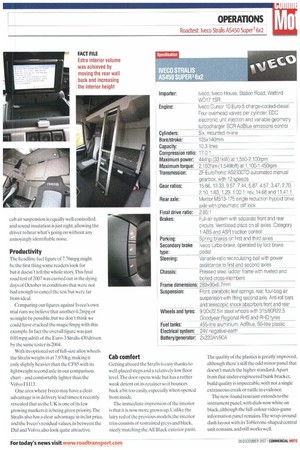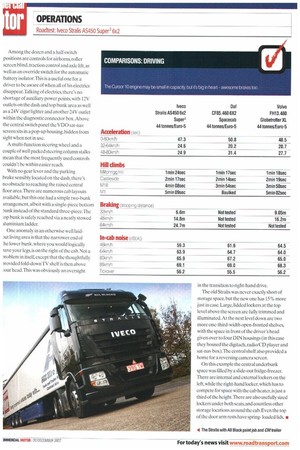With an appropriate All Black paint job, iveco's latest Stralis comes to
Page 45

Page 46

Page 47

Page 48

If you've noticed an error in this article please click here to report it so we can fix it.
CM'S test programme hoping for a better result than its rugby-playing
colleagues achieved. And it doesn't go away disappointed...
Few mid-life model revisions can have arrived amid as much ballyhoo as did the Iveco Stralis back in the spring of 2007. It coincided with the launch of Iveco's aggressive marketing campaign with sponsorship of the AU Blacks rugby team at its head. We won't dwell on the fact the All Blacks took a rugby world cup early bath, nor will we mention the unfortunate issue of the new model's hasty renaming.
But behind all this showbiz is a revised Stralis. Some of the changes apply across the hoard, but the most significant are restricted to two new variants, the Active Space and the Active Space Supee.
The name is inspired by the fact that the new cab has 1.8m3, or 20%, extra interior volume.This was achieved by moving the rear wall back by 90mm and increasing the interior height by 95mm — dimensions which broadly speaking give the shape of a cube —hence the name. Other significant interior improvements include larger bunks, more storage and higher-quality trim materials.
The AT (Active Time) sleeper and AD (Active Day) cabs continue to serve the short-haul fleet and distribution sectors as before, with the addition of the interior trim improvements.
For its UK Stralis range, Wee° has taken the unparalleled step of missing out Euro-4 completely, going straight to Euro-5. In the AS models this comes courtesy of the 10.3-litre Cursor 10 engine nominally rated at 450hp or the 12.9-litre Cursor 13 at 500 and 560hp. All Euro-5 Stralis models come complete with the OBD2 on-board diagnostics needed to claim the £500 VED rebate.with SCR and AdBlue used to control emissions.
A more established Iveco feature is fitting the EuroTronic-branded ZFAS-Tronic 12-speed automated manual transmission as standard, now with an "improved human interface system" (or better switches in old money).The truck on test is a top-of-the-range Stralis AS Super' with the 450 Cursor 10 running at 44 tonnes on a 6x2 mid-lift twinsteer chassis.
On the road Iveco has followed the welcome trend of relocating the gear-changing mechanism away from its traditional location to the left of the driving seat. Now that the gearstick has been superseded by a set of electrical contacts there's no need to pretend otherwise by cluttering up cross-cab access.
The main controls to make the Stralis go are three rocker switches on the dash: one for Reverse and Reverse Low; another for Neutral; and a third for Drive, Drive Low and Auto/Semi.They are coloured light grey to distinguish them from lesser controls. While this arrangement is not quite as logical as the single rotary knob in rival 2F installations, it does the job given the infrequency of its use in general driving.
The other more frequently used functions, such as manual (or semi-auto) override, are controlled by the right-hand column stalk. With the gears learned, all of two minutes later you're ready to hit the road.
Iveco's Cursor engines have acquired a eputation for punching above their weight, ierforming in the way you'd expect of an :ngine three litres larger, and this Euro-5 2ursor 10 doesn't disappoint. Performance ; impressively strong when you consider here are just 10.3 litres of displacement mder the floor.
One interesting sign of the times is a dash ibel warning the driver not to turn on the gfition for at least two minutes after the ngine is stopped, to prevent a backflow of dBlue through the system.
With Iveco's early commitment to the oncept it has been interesting to watch the ZF momated manual gradually mature, and the 'test version challenges the benchmark Volvo -Shift in Operation. Changes are invariably erfectly timed, but taking manual control ; just the lift of a finger away. Extra power is vailable from the throttle pedal kickdown, although it does need a good firm push to engage.
Sadly, a combination of bad weather and technical problems with our equipment has seen a dearth of brake testing figures in recent roadtests, but these were overcome for this test. Our proving ground emergency braking test is more extreme than any sane driver would want to experience on the road,but the bottom line is that the Stralis's braking results wouldn't embarrass a 3.5-tonne van.
The less good news is that the deceleration proved Lou much for the top bunk retaining catch, which came away from the roof and allowed the bunk to crash down to the horizontal, fortunately clear of the occupants' heads.
In more normal use the service brakes proved powerful and progressive, supported by an engine brake incorporated into the variable-geometry turbocharger.
The ride is unobtrusively firm with sharp handling,even when you introduce a bit of Italian brio to the driving style.The four-point cab air suspension is equally well controlled. and sound insulation is just right, allowing the driver to hear what's going on without any annoyingly identifiable noise.
Productivity The headline fuel figure of 7.76mpg might be the first thing some readers look for but it doesn't tell the whole story. This final road test of 2007 was carried out in the dying days of October in conditions that were not had enough to cancel the test but were far from ideal.
Comparing our figures against Iveco's own trial runs we believe that another 0.2mpg or so might be possible, but we don't think we could have cracked the magic 8mpg with this example. In fact the overall figure was just 0.01mpg adrift of the Euro-3 Stralis 430 driven by the same tester in 2004.
With its optional set of full-size alloy wheels the Stralis weighs in at 7,970kg, making it only slightly heavier than the CF85 with its lightweight second axle in our comparison chart — and comfortably lighter than the Volvo FH13.
One area where Iveco may have a clear advantage is in delivery lead times; it recently revealed that as the UK is one of its few growing markets it is being given priority.The Stralis also has a clear advantage in its list price, and the Iveco's residual values, in between the Daf and Volvo, also look quite attractive. Cab comfort Getting aboard the Stralis is easy thanks to well-placed steps and a relatively low floor level.The door opens wide but has a rather weak detent on its retainer so it bounces back a bit too easily, especially when opened from inside.
The immediate impression of the interior is that it is now more grownup. Unlike the lairy red of the previous models, the interior trim consists of restrained greys and black, nicely matching the All Black exterior paint. The quality of the plastics is greatly improved, although there's still the odd minor panel that doesn't match the higher standard.Apart from that under-engineered bunk bracket, build quality is impeccable, with not a single extraneous creak or rattle in evidence.
The new-found restraint extends to the instrument panel, with dials now white on black, although the full-colour video-game information panel remains.The wrap-around dash layout with its Toblerone-shaped central unit remains, and still works well. Among the dozen and a half switch positions are controls for airhorns, roller screen blind, traction control and axle lift, as well as an override switch for the automatic battery isolator.This is a useful one for a driver to be aware of when all of his electrics disappear.Talking of electrics, there's no shortage of auxiliary power points, with 12V outlets on the dash and top bunk area as well as a 24V cigar lighter and another 24V outlet within the diagnostic connector box. Above the central switch panel the VDO sat-nay screen sits in a pop-up housing, hidden from sight when not in use.
A multi-function steering wheel and a couple of well packed steering column stalks mean that the most frequently used controls couldn't be within easier reach.
With no gear lever and the parking brake sensibly located on the dash, there's no obstacle to reaching the raised central floor area.There are numerous cab layouts available,but this one had a simple two-bunk arrangement, albeit with a single-piece bottom 'punk instead of the standard three-piece.The :op bunk is safely reached via a neatly stowed Aluminium ladder.
One anomaly in an otherwise well laidJut living area is that the narrower end of :he lower bunk,where you would logically lave your legs, is on the right of the cab. Not a woblem in itself, except that the thoughtfully )rovided fold-downTV shelf is then above /our head.This was obviously an oversight in the transition to right-hand drive.
The old &rails was never exactly short of storage space, hut the new one has 15% more just in case. Large, lidded lockers at the top level above the screen are fully trimmed and illuminated.At the next level down are two more one-third-width open-fronted shelves, with the space in front of the driver's head given over to four DIN housings (in this case they housed the digitach,radio/CD player and sat-nay box).The central shelf also provided a home for a reversing camera screen.
On this example the central underbunk space was filled by a slide-out fridge-freezer. There are internal and external lockers on the left, while the right-hand locker, which has to compete for space with the cab heater, is just a third of the height.There are also usefully sized lockers under both seats, and countless other storage locations around the cab. Even the top of the door arm rests have spring-loaded lids. •
































































































































































































